Interview with Mike Wyatt, President of the American Model Yachting Association
Is This Really Sailboat Racing? Heck Yes!
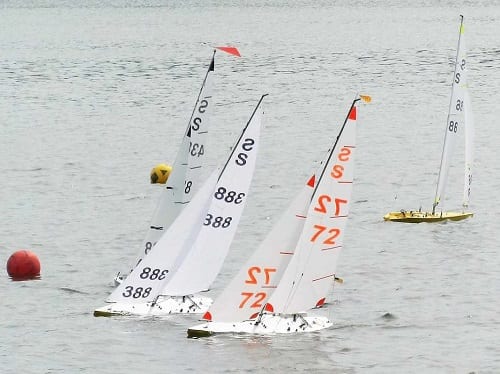
US Sailing: Tell us about AMYA?
Mike Wyatt: The American Model Yachting Association was founded 50 years ago as an informal organization, using a newsletter to communicate to and connect with its members. Currently, membership stands at approximately 2,250 members, though there are many more RC boat owners/sailors out there. We sanction about 30 different classes of radio controlled boats.
- 19 one design classes that are sanctioned by AMYA – rules that one design in nature
- 8 Development classes are very permissive in rules. Many are home built.
- A few vintage groups with boat designs before 1970, as far back as 1900.
US Sailing: What’s the history of model boat racing?
Mike Wyatt: Model sailboat racing started in the 1870’s. Back then, the boats were free-sailed, set and released by the skipper, sailed across the pond to an assistant who reset the sails and sent the boat back the other direction. After that there were mechanical means of steering, much like the early version of “autopilot” gear used on cruising boats.
Around 1970, radio-controlled sailing began to take over, and is now almost 100%. Although we still have sailors that race vintage boats using vane gear control.
- The oldest, still-active model sailing clubs in the U.S. are the Central Park MYC (Model Yacht Club) in New York City, and the San Francisco MYC Established in 1896. But model sailing started in the USA, in the New York area in 1872. There were three clubs that were eventually absorbed by the current one in Central Park.
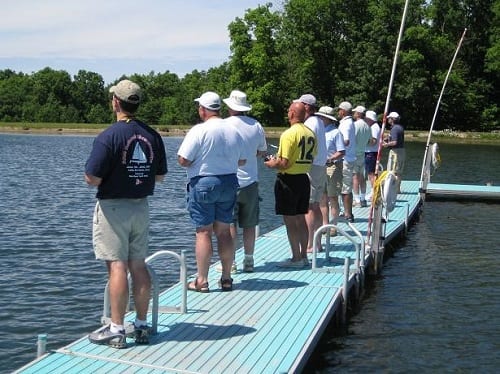
Mike Wyatt: I have heard sailboat racing described as “a chess game on the water,” with the strategy and tactics determining makes a difference between winning or not. Radio sailing is the “same game with different pieces.”
Radio sailing is low cost. You can get going with as little as $500 for everything a person needs including the boat, radio equipment, batteries and charger. The most expensive ($5000-6000) is a J-Boat design approximately over 100 pounds, about 8 feet long, and an open design heavy enough that the class generally requires two people to launch. One of the most popular “J Boats” is “Ranger” a model of the 1930’s America’s Cup winner, but with a Marconi rig.
Due to the low costs, it is feasible to own many RC classes. I have a friend who owns (per his wife’s count) over 50 RC sailboats, and several boats in some of the classes.
Radio sailing can be done by anyone, regardless of age, gender, or physical ability. We have radio sailors who are in wheelchairs, on scooters, and many who sail comfortably seated in a folding chair.
US Sailing: Is it really racing, or is it more like playing video games?
Mike Wyatt: Radio controlled racing has very little resemblance to a video game. You are still outside, in the wind and elements, watching an actual boat that you have to tune for the conditions and race around a course. I see people who were full scale sailors before, actually “ooching” with their transmitter – hands and bodies moving around as they try to “ooch” their boat along!
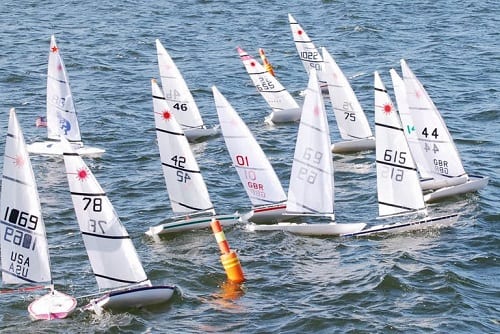
US Sailing: What are the key characteristics of the top model boat racers?
Mike Wyatt: In full scale sailing, physical aspects are different – you feel the boat. In radio sailing you only have your eyes and concentration is critical. Tuning is done before you launch. Model boats have vangs, adjustable backstays, adjustable mast rake and rig tension, and sheeting angles. All the same controls that are on a full scale boat need to be adjusted pre sail in model competition. If you get it wrong, its painful and you lose. You cannot make changes until between races, and then they have to be fast before the next start.
US Sailing: Do they practice much?
Mike Wyatt: Exactly like full scale sailors, the best RC sailors tend to have sailed more than the ones who perform at a lower level. We have past World Champions, Olympic sailors, and even one past Swedish Olympic Team Coach. Many top-level sailors from full scale racing are part of our sport. Bruce Farr, Bob Johnstone, Chuck Millican, and many other very good sailors are RC sailors.
On the other hand, Peter Feldman (to my knowledge) was never a full scale sailor. But he is currently a National Champion in several RC Classes, and has only been in RC sailing for less than 5 years!
Because radio sailing is easier, you can “go sailing” in a one-hour block of time, even for just a few minutes. Many radio sailors sail more than they ever did in their full scale days. It is not impossible for RC sailors from some clubs to put in six days a week racing, in up to six to eight classes! My club (Western Reserve MYC in Northeast Ohio) will do over 600 heats/races per year – in seven months’ time. Equate to 80-90 races a month racing two to three hours a day. The less active clubs sail two days a week; the more active sail six days a week, and two classes a day. The bonus is that RC racing is very family friendly since racers can get home in a couple of hours to do other activities.
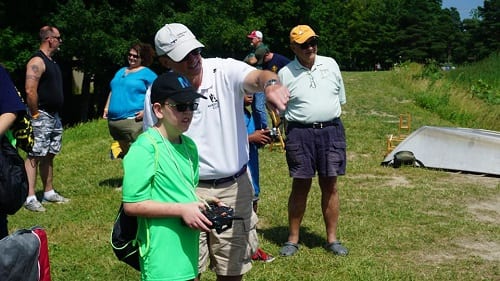
US Sailing: Do they play by the rules?
Mike Wyatt: Sailors, as you know, are competitive!
US Sailing: Speaking of the rules, how different are the rules to the regular Racing Rules of Sailing?
Mike Wyatt: Yes, we sail by the same Racing Rules of Sailing as used all over the World, with just a few variances because of the nature of our sport.
Appendix E of the RRS states the variances used in radio sailing-
- “The Zone” is four lengths, not three.
- “There are no Protest Flags – a racer protests verbally since he or she is on land within a few feet of the other sailors.
- The Start is signaled using a recorded countdown of two minutes – but usually just One Minute, No flags.
- Many clubs allow touching Marks (except the Start or Finish marks), because you are not ON the boat to see the Mark as well as you would in full scale sailing.
US Sailing: Do you find that model boat racers tend to race other boats too?
Mike Wyatt: About 50% of the sailors from my RC club have never been on a full scale sailboat. I think that active full scale sailors have no significant advantage from being full scale racers. The most obvious advantage for the full scale sailor might lie in the tuning aspects of the boats. Kids, women, and folks with physical challenges do not have a weight or strength disadvantage. Many of us sit down while racing.
Coaching is routinely done by the more experienced, gold fleet sailors for the less experienced. There are training sessions where these sailors work with those who want to learn and get better in RC boats. These sessions primarily involve tuning and sometimes include boat handling drills.
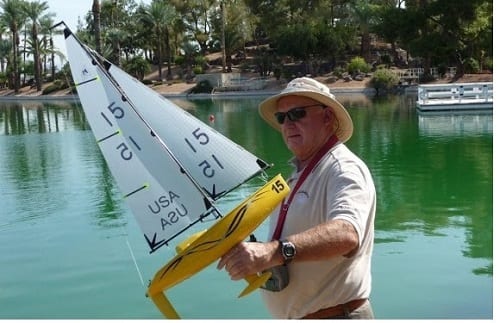
US Sailing: What are the most popular boats and where are they being sailed?
Mike Wyatt: The #1 boat in the USA and Canada is the Soling 1 Meter. There have been more than 10,000 Soling 1 Meter kits sold, and 687 of the 2,250 AMYA Members, own over 1,000 Soling 1 Meter boats. It is approximately a 1/8 scale model of the International Soling. The Soling is sold as a Kit that takes maybe 30-40 hours to build. But with the popularity of the class, it is easy to find a used RC Soling, and like any one design, a good used one is as competitive as a new one.
And, in every club there is likely someone who will build a kit boat for you, for around $700. Divide by the hours and you see that professional building is a labor of love. The guy building a Soling for you does that for around $ 10 an hour!
The second largest and fastest-growing RC Class is the Dragon Flight 95. The DF95 has 560 AMYA Members owning over 600 boats. This boat is a strict one design, sails well, is light and quick, and has an active class in terms of clubs and regattas. DF-95s as well as the smaller DF-65 are being sailed at full scale yacht clubs as one design fleets. The 95s were even sailed at the 2019 San Diego NOOD regatta! The 2020 San Diego NOOD DF-95 event was also scheduled- but was canceled due to COVID-19. The growing popularity of this one-design is also because it is sold almost ready to sail. You can put one together in a couple of hours, just knowing how to tie a few knots. And it is a great value at a little under $400.
Another is the RC Laser, pretty close to the prototype model of Bruce Kirby’s design, is actually a little longer than 1 meter. It is a strict OD and ready to sail out of the box.
Just like in the society as a whole, people are looking for things that are ready to go, rather than having to be built. So, a used boat, a kit or a ready to sail boat is an early choice people have to make.
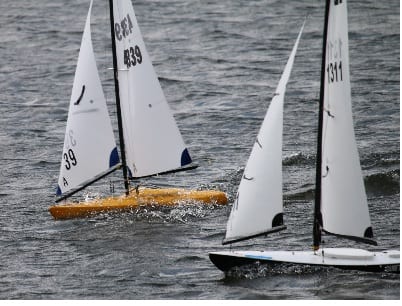
US Sailing: How would you characterize the average model boat sailor?
Mike Wyatt: We have no real statistics. But I would say the average AMYA Member is in his or her early 60s, so many are retired. But we have sailors that range from young teens to mid-80s. Just like full scale sailors, we like to have a good time. But the AMYA has clubs in over 30 States and Canada, so there is a wide variety of people, from all backgrounds, who are active RC sailors.
I raced International FJs (Flying Juniors) for 40 years, was the Class President and the Chief Measurer, and have raced RC since 2007. Once I picked up a transmitter, I gave my wetsuit and PFD away!
US Sailing: How complicated is the equipment? DO people change gear regularly, new sails or other parts/pieces?
Mike Wyatt: Not complicated at all. Most RC boats have just two servos, one that controls the sheeting angle, and another that controls the rudder. The boat has a receiver to get signals from a transmitter, which is in the hands of the skipper. Range is about ¾ miles – more than you would ever want.
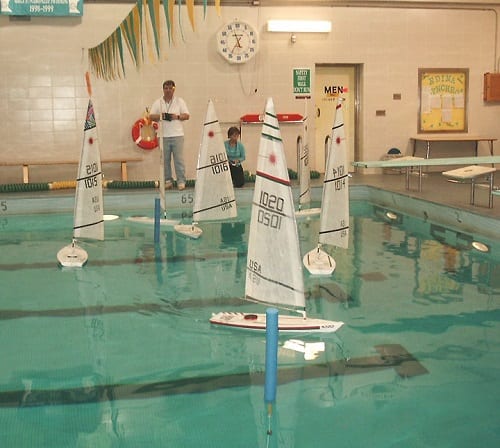
Just like in full scale boats, sails are faster when they have good shape. Most RC boats use Dacron sails, although some allow mylar and some less costly ones use nylon sails. A full suit of sails, main and jib, is around $80-$150.
US Sailing: Are some venues preferable? Ponds, pools, bays, rivers, current, no current?
Mike Wyatt: RC sailing is possible on almost any body of water, and in winds from a near calm to over 20 MPH. Boats can be tuned to handle more wind, and some classes have multiple rigs for different wind strength, even pools with fans will allow winter sailing! Set the fans up with “offset” for preferred tacks.
US Sailing: How do you set courses and handle starts? Is there a race committee?
Mike Wyatt: Races are generally 5-15 minutes in length. Our club sails 12 races a day! That is another advantage of RC sailing – lots of action. A 1-minute Start sequence on a 12-15 foot line with 12 boats can be bedlam. So, we get a lot more starts, mark roundings, and close competition than is typical in full scale racing. Even more than collegiate racing!
There is a race director who does not complete. He/she sets the course, starts the clock on a one- or two-minute cycle and we are off! Most big regatta courses use W/L courses of 100 – 150-foot legs. In club races, most are triangle courses. Normally, championship fleets will sail full legs, starting at the leeward end, and finishing in the middle. Club races might start and finish in middle.
US Sailing: Is it difficult to get involved? What does it take? Is it expensive?
Mike Wyatt: Easy. First, go the AMYA Website: www.theamya.org
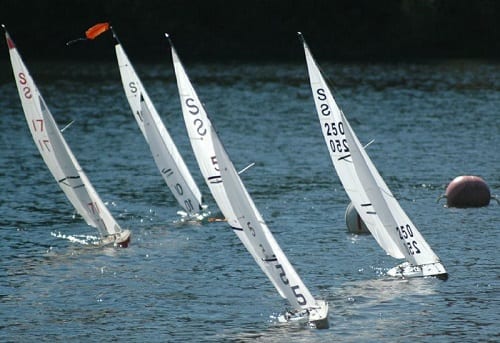
On page 1 of the website, there is a link to the AMYA’s 200th Issue to Model Yachting, our quarterly magazine, and the only magazine on our sport in the world. This issue was the 200th one of our magazine, and also celebrated the 50th Anniversary of the AMYA. It is online, free, and all-color. Issue #200 will give you a great look at the sport, the history, and the classes in radio sailing. Click Here.
Anyone who is interested should look at what AMYA Clubs are available in their immediate area, and then contact them for a visit. Click here.
Every club welcomes new people and has a list of available used boats to buy (if not actual club-owned boats available for sale or to borrow). The club members will give a prospect good guidance on how the get started, and let you sail an RC boat. Many will even allow a prospective sailor to race one of their boats in a club race. Come join us – our mantra is KISMIF – “Keep it Simple; Make it FUN!”
*All photos in the article are courtesy of AMYA.
